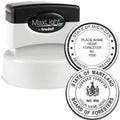ESS Blog

Unlock Your Potential with the Right Colorado Notary Kit
Optimize your professionalism and streamline every signing with the essential Colorado Notary Kit that saves time, boosts confidence, and sets your mobile or office notary apart.

Why You Need Quality Colorado Notary Supply Today
Optimize your notary business with state-approved Colorado stamps, seals, journals and embossers chosen for durability, compliance and fast shipping.

Why You Need a Reliable Colorado Notary Seal and Stamp
Fortify your Colorado notarizations with a durable, state-compliant seal and stamp that prevents tampering, avoids costly rejections, and boosts client trust.

Get Your Notary Stamp for Colorado Without the Hassle
A fast, affordable, stress-free way to get your Colorado notary stamp—complete with same-day delivery, custom kits, and expert guidance—so you can save time and meet state requirements.

Top Notary Supply Colorado Picks for Every Public Notary
Find Colorado’s top notary stamps, embossers, journals and kits—plus pro tips and fast-shipping options for Denver, Colorado Springs, Boulder and mobile, remote online or newly commissioned notaries.

Your Search for the Best Official Colorado Notary Stamp Ends Here
Get the perfect Colorado notary stamp—compliant, durable, stylish, and easy to order to boost credibility and simplify every notarization.

















